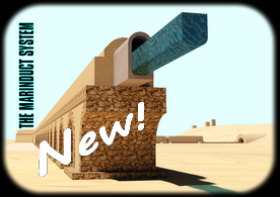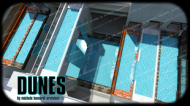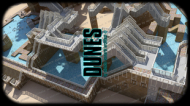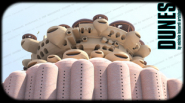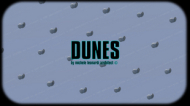THIS "WORLD"
on line since 2012, is mainly dedicated to architecture and urbanism. It is not a site conceived only for
specialists, but for anyone interested in architecture. For
example, two masters of modern architecture like Frank
Lloyd Wright and Le Corbusier, were not graduates. Otherwise looking at the distant past, the Roman emperor Hadrian, the
director of a masterpiece of all time such as Villa
Adriana near Tivoli, not even he was qualify himself as "graduate in
architecture". And not counting the architectures without architects that dot the world: from the trulli of Alberobello in Italy to the tulou in China, from the French cathedral builders in early second millennium up to the oasis of Sahara in the last millennia. Until to get to one of the oldest rights of the world: that of building
your home yourself. But this does not mean that anyone can improvise as an architect, especially in our day, in the age of specialism, cloning and absolute conformism.
Second, there is an EXTRA CONTENTS
section dedicated to multidisciplinary themes. More: this is a professional and personal website
with universal cultural purposes. Here is not propagandized any doctrine,
nor any final truth. Of course I advertise my projects, ideas and
opinions in terms of architecture.
The meta-message included into the Extra Contents is essentially aimed to the "not
born old" new generations: don't let yourself be overcome by pessimism and by Cassandras. Don't believe in clichés and the ignorance spread by the mass media, nor in certain forms of scientific
dogmatism. Because humanity today has all the knowledge available and all the modern and traditional technology to solve any real problem, including the energy transition, indeed, not a problem, but a new opportunity and a new frontier.
WHAT IS A SYSTEMIC HABITAT?
The principles of Systemic
Architectures and Constructions are exposed in my essay in two volumes, text and designs: TOWARD A DIFFERENT
HABITAT :
36 PROJECTS AND REALIZATIONS OF LUIGI PELLEGRIN ARCHITECT.
The introduction or the summary is
available also in:
Italian, German, Portuguese, Spanish, French, Russian, Arabic, Hindi, Chinese, and
Japanese.
However, in a nutshell, the basic assumption is that nature is systemic. It's still valid that nature is the best teacher, "natura
naturans", without for this reason divinizing it. All this beyond the form that an architecture or a building can take, because, as is well known, the forms are
unlimited. Man and society are not outside nature, but inside nature (Serge Moscovici, 1972), being themselves nature. Let
us not forget.
IN OUR TIMES
the common opinion is that
architecture is something more, a kind of ornament, the superfluous for rich people. This is a big strategic error. On the opposite many past civilizations have lasted for a long time exactly because these civilizations have recognized
the fundamental and organic function of architecture in the society. So here it is proposed to follow the way of Systemic Habitats and long-term strategies.
IF THE
Systemic Habitats' intents
will be emulated in the future, this will be one more step towards liberation from current building practice, given by inhuman piece's logic, the sum that is never a sum, which
results in the anonymous modern cities: “the grandma's old pie crust”, as rightly Frank Lloyd Wright called them, more or less.
The name for the theme we are dealing with here is
not random. Habitats indicates the spaces of living, the places where people live and carry out their
activities; from the basic living cell, to the architectural organism,
up to the urban and territorial scale. While the
adjective Systemic indicates that the components of a given architecture or construction make system with each other.
THAT'S ALL?
No, because the evolution of a project
is never linear. It has no limits, it is not predictable. Two, three good ideas and you can create a world, a new dimension for people. It's wasted time to enunciate a recipe ready to use for any
occasion, or formulate a program, or define an algorithm. Therefore, here and in my e-book we rather indicate a direction, a method among the many possible and not "the method". Examples are given by realized
and unrealized projects. George Bernard Shaw (1856-1950) suggested that "for every complex problem, there is always a simple solution which is wrong". In other words, architectural research cannot be channeled and limited by theorizing of any
kind.
The history of architecture and urban
planning shows how long any formalism last: not for long, having been born old, an example, the Post Modernism. Time before the postmodernist formalism, one master of modern architecture like Le
Corbusier, about his famous Modulor, a system of architectural proportioning he conceived and based on human dimensions, it seems to have
said paradoxically: “Le Modulor? Je m'en fiche! Quand cela ne fonctionne pas, il ne doit pas être
appliqué." The Modulor? I don’t care! When it doesn't work, it shouldn't be applied. In other words his clear rejection of any formalism. So it is a matter to define an
architectural language for contemporary life. It's a question of raising the qualitative level of common building practice.
ALL THIS IS POSSIBLE
only by following the mother road of
continuous architectural research. Since we are always talking about organic
architecture. There are no shortcuts, at least for us.
We stop here, at the doors of a future
unknown to us.
While its seeds are already here and
now, spread between us.
W E L C O M E
T O S Y S T E M I C H A B I T A T S
B Y M I C H E L E L E O N A R D I
A R C H I T E C T








